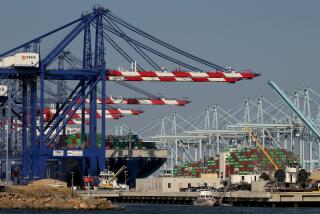Women Prove They Can Tote Those Bales on Docks
- Share via
WILMINGTON — Most women dockworkers who took a controversial strength and agility test have passed the exam, but only after many were given a second chance because a faulty machine was used in the first test, shipping officials announced.
Of the 140 women workers who originally took the test, only 62 passed, according to the Pacific Maritime Assn., an employer’s group that administered the test along with longshore union officials at the ports of Los Angeles and Long Beach.
But after it was discovered in late January that a machine used to determine how much weight a person could lift was inaccurate, those who flunked that portion of the test were allowed to take it again.
Thirty-six women who retook that part of the test scored enough additional points to pass it, the employers group said.
29 Men Pass Retest
By comparison, 1,780 men originally passed the test and 45 failed. After the faulty machine was fixed, the number of men who scored a passing grade increased by 29.
The employers and longshore officials began giving the test last December. The three-part test is designed to test arm and upper-body strength as well as equilibrium.
The test affects temporary dock workers--known as “casuals”--who are not union members and typically work only during peak periods. Registered longshoremen are not required to take it. Officials maintain the test is necessary to ensure a qualified work force.
Many casuals, however, have complained that the test discriminates against women and older men.
Same Test for Both Sexes
Cheryl Olivas, a 34-year-old dockworker who initially flunked the test but passed after she retook the upper-body portion, said this week that she still believes the exam is unfair because all men and women take the same test and are scored on the same basis.
“There is no way an older man or woman is going to be as strong as a 6-3, 220-pound young man,” Olivas said in an interview.
Olivas also said she believes that dockworkers who were temporarily barred from the docks because they had failed the initial test should be given back pay. After she initially flunked the test in early December, Olivas could not work on the waterfront until she passed it last month.
Employer and union officials have said that all workers are given the same test because temporary dockworkers are required to do all types of waterfront jobs. Employer officials said they do not believe the casuals, who are not guaranteed work, are entitled to back pay.
May Not Show Up
“Because there is no certainty a casual will show up and volunteer for work, or there will be work available, we maintain they have no back pay coming,” said Carie Schwab, assistant area manager for the employers group.
Union officials could not be reached for comment.
The faulty machine was discovered after three identical machines used to measure upper body strength were brought to Wilmington from other West Coast ports where the tests have been administered, employer officials said. The machines were brought in to speed up the testing process.
“Four different machines were giving different readings,” said Terry Lane, area manager of the employers group, so the machines were recalibrated to insure accuracy.
An estimated 500 temporary dockworkers have not taken the test. Testing has been halted until enough of them sign up, Lane said.
More to Read
Sign up for Essential California
The most important California stories and recommendations in your inbox every morning.
You may occasionally receive promotional content from the Los Angeles Times.










